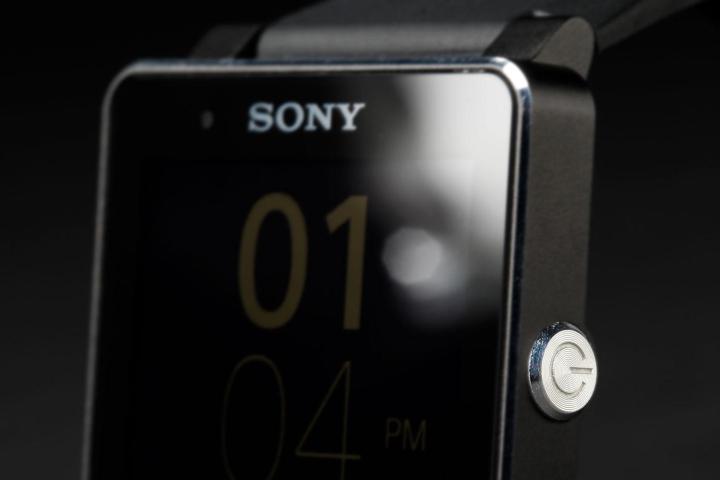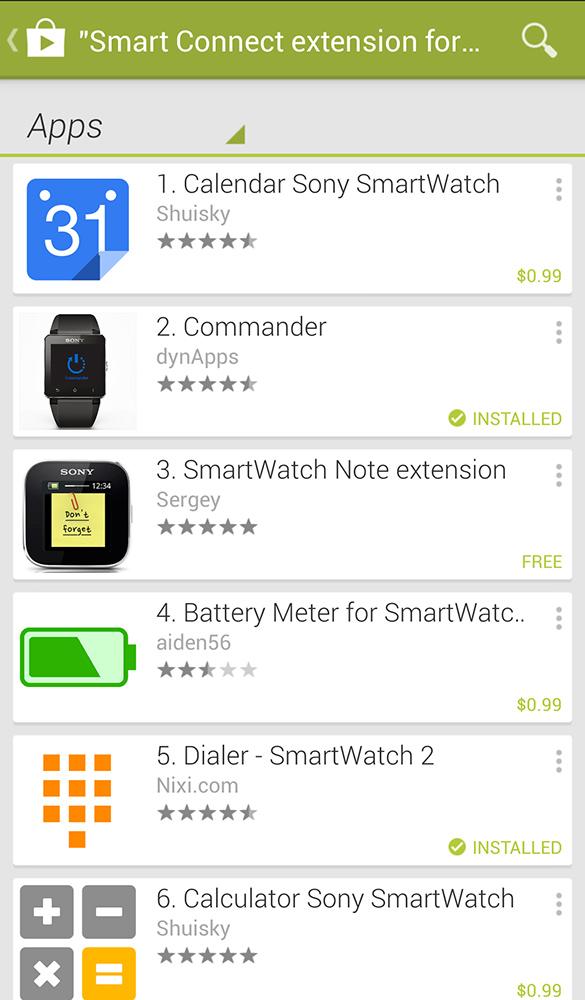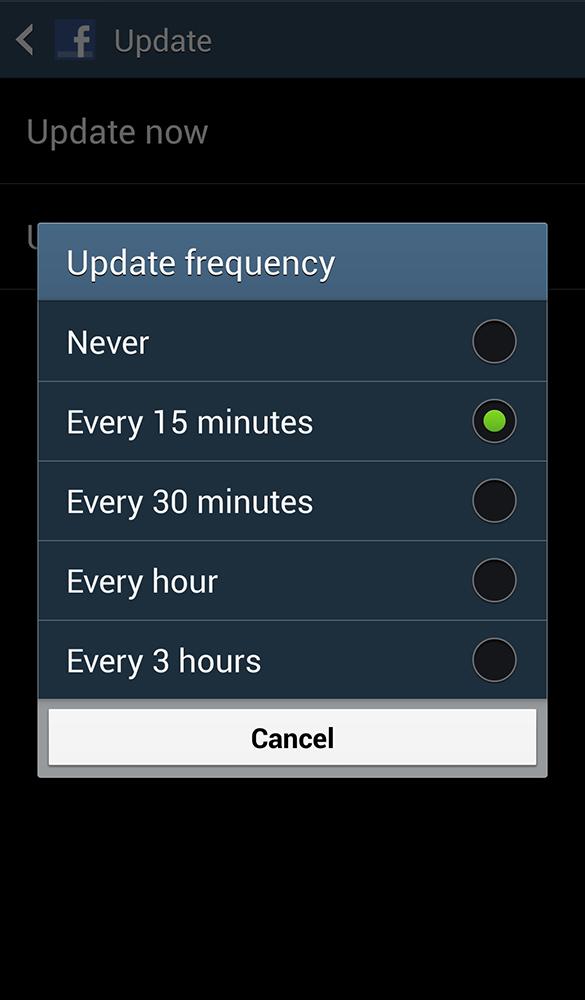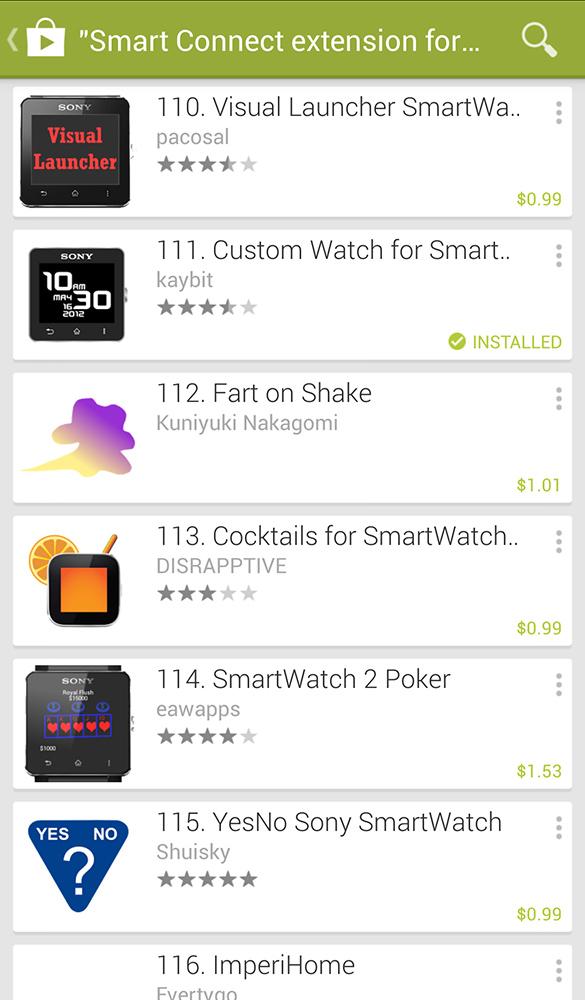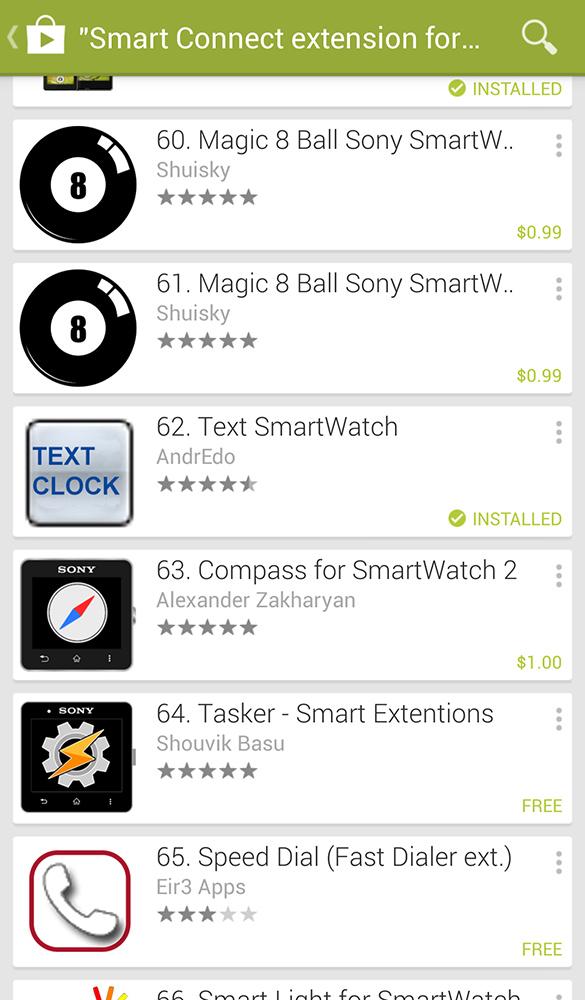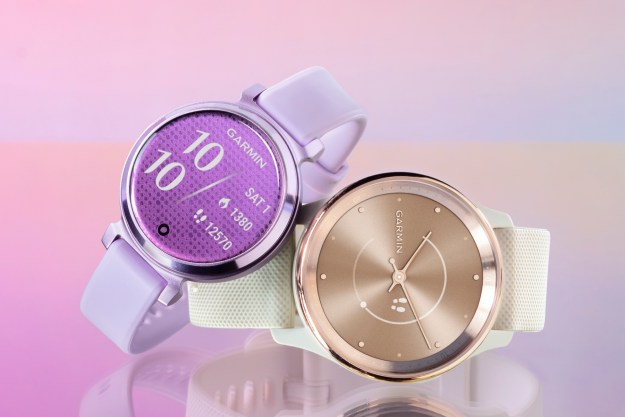
“With more apps, better notifications, and a lower price, the Smartwatch 2 is more appealing than Samsung’s Galaxy Gear, but not by much. Those looking for a slick, simple smartwatch experience will have to keep waiting.”
- Works with any Android 4.0+ phone
- Battery lasts 3 days
- A decent selection of apps
- okay to wear in the rain or in the shower
- Micro USB charging port
- Power button stiff and uncomfortable
- No mic for voice commands/dictation
- Notifications better than Galaxy Gear, but still flawed
- Many third-party apps aren’t great
- App searching and install process is tedious
Sony’s Smartwatch 2 hit the market around the same time as the Galaxy Gear, though with much less fanfare (or marketing push). It’s a less-ambitious offering (there’s no built-in camera, speaker, or mic), with a more modest $200 price tag. And because Sony’s been at the smartwatch game for a while, (hence the “2” in the name), there are a fair amount of third-party apps available for the device, which adds to its functionality and appeal.
Does fewer hardware features, but more apps and a better notification system make Sony’s Smartwatch 2 more appealing than Samsung’s Galaxy Gear? We’ll delve into that subject in detail below. But one thing’s for certain: The Smartwatch 2 undoubtedly has a broader potential user base.
Sony says its watch will work with any Android smartphone running 4.0 (Ice Cream Sandwich) or later. (We paired it with our Galaxy S4.) Samsung’s smartwatch is only compatible with a tiny (though growing) list of recent Samsung-made smartphones.
A familiar design
If you’re familiar with Sony’s recent Xperia smartphones, then the Smartwatch 2 should look familiar. The watch’s exterior shell borrows heavily from the likes of the Xperia Z, sporting a square design with rounded corners and a silver ring around the face.
The left side houses a standard Micro USB charging port behind a plastic door/plug. This is both good and bad. You won’t need an awkward charging cradle like you do to charge the Galaxy Gear – a good thing. And the plug keeps the port securely covered when it’s not in use, giving the watch an IP57 rating, which means it should survive in up to three feet of water for up to 30 minutes. More importantly, it means you don’t have to avoid using it in the rain, and you should be able to wear it in the shower— also good. We particularly enjoyed getting email notifications while in the shower.
But popping the door off of the charging port on the watch can be a pain, especially when you’re tired and trying to go to bed. You basically have to jam a fingernail into a small lip at the top and pry out. It’s not too difficult once you get the hang of it, but it’s still too fiddly for a last-minute nighttime activity. Still, we much prefer the Smartwatch 2’s built-in standardized port to the clunky charging cradle of the Galaxy Gear.

The right side of the Smartwatch 2 houses a big silver metal power button. It’s attractive enough, and reminiscent of the crowns on analog watches, which are used to adjust time and (in non-powered watches) for winding.
But on the Smartwatch 2, the power button’s position feels awkward – more so than on the Galaxy Gear, which has its power button in a similar place. The problem with Sony’s button is it’s far too stiff (difficult to press) when the watch is on your wrist. And, just like with the Galaxy Gear, pressing the button on the side of the Smartwatch 2 often caused painful pulling of our arm hair.
You’ll also be pressing that power button a lot more on Sony’s device than you need to with the Galaxy Gear, because while the Gear has a motion sensor that switches on the screen (too slowly, we’ll add) with the flick of the wrist, you’ll have to hit the power button to light up the screen on Sony’s device.
We particularly enjoyed getting email notifications while in the shower.
To be clear, the Smartwatch 2 has a transflective screen. That means that the watch face with the time display is viewable at any time, but it isn’t backlit until you press the button, so it can be hard to read in dim environments (especially if you’re using one of the analog faces). Press the button once, and the backlight comes on. Press it twice, and you’ll get an Android-like screen that you can swipe through to see and launch apps (much more on that soon).
The other reason you’ll probably be pressing the stiff power button is because when you get notifications, be they emails, Twitter or Facebook messages, or texts, they only stay on the screen for about 10 seconds. Fail to glance at or tap the watch in that amount of time, and they go away, and you’re left just looking at the time.
You can, of course, jump into the watch’s apps and find those notifications with a couple button presses and swipes, but if you’re going to all that trouble, in most cases, it would be easier to just take out your phone.
We reached out to Sony to see if there was a way to extend the amount of time notifications remained on the screen – we’d be happy to be able to up the on-screen notification time to 15 or 20 seconds – a rep told us there was no way to do this at the moment, but the company is “definitely looking into things such as this for the next firmware update.” We hope Sony adds this option soon, but we’re also fairly certain doubling the on-screen time for notifications would cause a big hit to the Smartwatch 2’s claim of two- to three-day battery life.
But the Smartwatch 2 seems to have some battery life to spare. In our tests, with fairly heavy use, only turning the watch off while we slept, we got a full three days of use. And it wasn’t until 10:30 on the third night that the watch kicked up a notification telling us that the battery was at 10 percent.
As for the overall look of the Smartwatch 2 itself, we’d say it’s okay for most users likely to pick up a smartwatch at this point (tech enthusiasts and businesspeople). But it certainly won’t win any style points from fashion experts. The Sony logo above the screen is, we suppose, expected. But there are also a trio of persistent silver capacitive touch buttons on the bottom of the watch face, which make the face look cluttered. They certainly make navigating the watch a familiar experience Android users, but we wish the buttons were backlit, and not etched into the watch face, so they could disappear when not in use.
Sony also sells replacement silicone wrist straps for the watch dour colors other than the black that ships with the watch, as well as two leather straps. And a slightly pricier model ($220) with a black metal band is also available directly from Sony.
You can also replace the straps with standard 24mm watch straps. That’s a good thing, particularly for those with small wrists: Our review unit fit comfortably on our wrist at the second-to-last notch in the strap. And we wouldn’t consider our wrist overly small.
Screen & basic navigation
As we said earlier, the Smartwatch 2 has a 1.6-inch Transflective display. Its 220×176 pixel resolution isn’t as crisp as the 320×320 screen on the Galaxy Gear. Nor does Sony’s screen look as bright. But its Transflective tech does make the watch readable in sunlight. And while some text and icons on Sony’s device look jagged, we really don’t care. A smartwatch should be a device you glance at, not linger over. The screen here is plenty good enough to deliver readable text and nice-enough graphics, without any viewing angle issues. You can use a slideshow app to swipe through your photos, but we’re not really sure why you’d want to.
The Smartwatch 2 seems to have some battery life to spare.
If you double-tap the power button, or hit the button once, then tap the home button on the front, you’ll be dropped into an Android-app-drawer like screen with six icons viewable, a battery meter up top on the left, and the time in the upper right.
Swiping left scrolls through all your installed apps, six at a time, and tapping on one will, of course, launch the app. We wouldn’t exactly say the Smartwatch 2’s performance was snappy, but it didn’t feel overly sluggish or suffer any serious lockups when we used it, either. That’s about how we felt about the Galaxy Gear as well. The performance of both devices is good enough. We don’t expect the kind of responsiveness from a single-core smartwatch that you’ll get from a high-end, quad-core smartphone, and you shouldn’t either.
Setup & apps
In theory, you should be able to pair the Smartwatch 2 with any Android 4.0 or later smartphone with an NFC chip just by tapping the back of the watch to the back of your phone. When we did this with our Galaxy S4, though, nothing happened.
But after we headed to the Google Play Store and installed Sony’s Smart Connect app (which you’ll need to download and install apps for the watch), tapping the phone to the watch paired the two devices automatically after a few seconds. If you don’t have an NFC-enabled phone, fear not; you can pair the devices via the standard Bluetooth method as well.
Once the devices are paired, you’ll want to start installing apps. While the apps are available via the Play store, you’ll need to search for them via Sony’s Smart Connect app. If you click on an app, decide you don’t want it, and hit the back button, you get dumped into the regular Google Play Store, not Sony’s Smart Connect app. You’ll then have to navigate back to the Sony app and search again to get back to the smartwatch apps. This is a disorienting, confusing process that needs to be fixed if Sony hopes to attract more than ardent tech enthusiasts to this device or future models.
Only a few apps come pre-installed with the Smart Connect app, so you’ll probably want to do a lot of installing at first. Sony’s own notification apps for Twitter, Facebook, Gmail, etc., must all be separately downloaded if you want to receive notifications from those services. Then you’ll need to log in to those accounts separately via the Sony app to get them to work. Again, this makes the Smartwatch 2 feel more like something for those who enjoy fiddling with tech than those who want to pick up something that mostly just works and makes their digital life easier.
Paying for such simple apps seems a bit much to ask, especially since free versions are available for smartphones.
There are a significant number of third-party apps as well. We counted about 160 that are optimized for the Smartwatch 2. And that number roughly doubles if you include older apps that will work with the device, but were designed for the older, smaller-screened Smartwatch 1.
Three hundred or so smartwatch apps may sound like a lot. It’s certainly many more than Samsung’s Galaxy Gear can boast. But keep in mind roughly half of those apps won’t look all that good, since they aren’t optimized for the Smartwatch 2’s screen. And of the other half, many are essentially pointless (there’s a magic 8 ball app and several flashlights), many are redundant (there are several phone apps with number pads and caller ID), and many of the apps, while functionally simple, aren’t free. Most of the flashlight apps and calculators, for instance, are priced at a dollar or more. We have no problem paying for apps. But paying for such simple apps is a lot to ask, especially since free versions are available for smartphones.
Sony has written a few apps that are mostly functional, like the Gmail and social media notification apps, but many are far from perfect. The Music Player app, for instance, worked well enough if we stuck to only using Google’s Play Music app. The app displays cover art, lets your swipe to change tracks and adjust volume with a tap. But you’ll need to go to your phone to change albums.
But when we switched to using Amazon’s MP3 player to play music, swiping to change tracks with the Music Player app usually switched the phone back to playing tracks from the Play Music app. And once, with Google Play and Amazon MP3 both running on the phone, we tried changing tracks playing in the Amazon app, and our phone started playing an entirely album that, after some investigation, we realized was playing in Android’s old Music app, which we haven’t used in months.
When this happened, the Smartwatch 2’s screen also stayed on for several minutes – which must be a glitch – as the watch has a tendency to aggressively switch the backlight off and revert to the watch to conserve battery life. It was only after we pressed the watch’s power button that the screen’s backlight turned off.
The Smartwatch 2 does come with a free code for the $5 Runtastic Pro fitness app, which looks good and generally works pretty well on the watch, letting you start and stop exercise sessions. We’d like to see several more high-profile apps like Runtastic available for the watch, instead of the dozens of mostly lackluster offerings currently available – many of which aren’t free. Sony’s Smartwatch 2 does have more useful apps overall than the Galaxy Gear did when we reviewed it. But the app disparity between the two devices isn’t as great as the sheer volume of apps available for Sony’s device would make you think.
Notifications are better than the Gear, but still broken
One of our main complaints about Samsung’s Galaxy Gear was its notification system. That watch feeds you text messages and info on who’s calling. But when it comes to Facebook, Twitter, and even Gmail, it just tells you that there’s a new message, without feeding you any of the actual content, or even who messaged you.
When you get notifications, they only stay on the screen for about 10 seconds. Fail to glance at or tap the watch in that amount of time, and they go away.
Notifications on Sony’s Smartwatch are better for the most part. Text messages and Gmail notifications come through immediately. And they tell you who sent them and give you a few lines of text. Sony tells us they’re also working on expanding the amount of text that gets delivered via notifications in an upcoming software update so you could, in theory, read entire emails.
But when it comes to Facebook and Twitter notifications, things are more problematic. The good news is that you can jump into settings on the phone to check and uncheck boxes to determine when you’ll get notifications. If you want to drive yourself nuts, you can get an alert whenever any of your friends posts anything, or whenever someone you follow tweets. We quickly unchecked all of our followers and friends, and elected to just get notices when someone sent us a direct message or we got an @ mention, or when someone sent us a
That’s all well and good. But the settings of those two apps reveal another big flaw with notifications here. At least with these two apps, the shortest update frequency you can choose is every 15 minutes. Of course most of us don’t need to get our social media notifications delivered as soon as they’re sent. But if you’re buying a smartwatch to get notifications without having to pull out your smartphone, you probably really want those notifications to come through instantly. Gmail and text messages, at least, come through just a few seconds after they hit your phone.
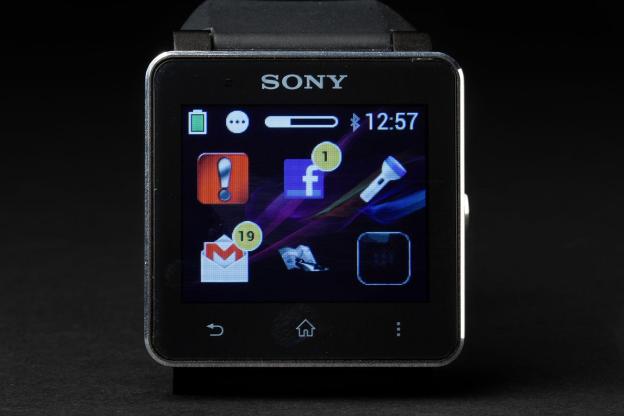
Again, the update frequency limitation is likely done to conserve battery life. But at the moment at least, getting notifications without having to pull out your smartphone is one of, if not the main selling point of snartwatches.
As far as we’re concerned, if a smartwatch can’t deliver all your notifications to your watch within seconds of when they land on your phone, tell you who they’re from and deliver at least the first few lines of text, it’s fundamentally flawed. Sony’s watch does notifications better than the Galaxy Gear, and either device could be substantially improved with a software update at any time. But at the moment, neither device does notifications nearly as well as the lower-priced Pebble.
We don’t miss the Gear’s built-in camera, but we do miss the microphone
A Sony rep told us that they feel one of the strengths of the Smartwatch 2 is that the company didn’t overreach on the functionality front. We’re sure that was a subtle dig at the Galaxy Gear’s built-in camera and speakerphone. The camera on that device isn’t great, or arguably necessary; given that all smartphone cameras we’ve tested are better. And while the speakerphone on the Gear works well, we can’t think of many situations where we’d want to stand around talking to our wrists while broadcasting the other side of the conversation to anyone nearby.
The Smartwatch 2 lacks those features, and that’s mostly fine. Especially since doing so gets the price down to a more reasonable $200. But we do wish there were a microphone on the Smartwatch 2. Granted, adding a mic would likely kill the watch’s water resistance. But we’d really like the ability to use Google’s text-to-speech functionality to dictate responses to text messages. The Messaging app for the Smartwatch 2 does let you scroll through a list of pre-written canned responses, but that’s nowhere near as convenient as being able to give a real response by just talking into your wrist.
Conclusion
Sony’s Smartwatch 2 is a solid effort, and a bit better than Samsung’s Galaxy Gear – especially given it costs $100 less. Sure, you don’t get the camera or the mic, but you do get a decent selection of apps to play around with, which makes Sony’s offering feel more versatile, despite the extra hardware on Samsung’s device.
Messaging is also better on Sony’s watch than Samsung’s, but both devices fall down on the job here. A smartwatch needs to deliver all your notifications instantly and tell you who they’re from and what they’re about. Neither device gets there at the moment.
And likely at least partially because of the available third-party apps (many of which look and feel hastily thrown together), the Smartwatch 2 feels buggier than the Galaxy Gear. Sony’s device, with its extra apps and more traditionally Android-like experience is more fun to play with if you’re a geek who likes to explore and tinker with hardware and software, but neither device feels ready for mainstream adoption.
And we’d really like to see a microphone on the Smartwatch 2, for both dictating texts and email, but also for the more interesting functionality it could bring. A mic would be handy for use with the expanded Google Now functionality that’s built into Android 4.4.
Imagine holding the phone to your wrist and saying “OK Google, give me directions to_____” and having Google Maps pop up on your phone while a voice tells you how long it’ll take to get where you want to go. That’s the kind of functionality that seems should be easy to implement (it already exists on smartphones), but we just aren’t seeing yet from anyone. Perhaps Google wants to keep these kinds of features for Google Glass and perhaps its own smartwatch.
But until that kind of truly game-changing functionality, or something similar, makes it into a smartwatch we don’t see the Smartwatch 2, the Galaxy Gear, or the Pebble becoming more than niche devices. The hardware seems like it’s just about good enough. But software is, for the most part, severely lacking. And big as Sony and Samsung are, it’s likely going to take a device from a company with an established money-making ecosystems, like Apple or Google, to get app developers to take smartwatches seriously. Until that happens, or until another company invests as much or more in software development as it does in hardware, smartwatches will continue to be the next big thing, not the new big thing.
Highs
- Works with any Android 4.0+ phone
- Battery lasts 3 days
- A decent selection of apps
- okay to wear in the rain or in the shower
- Micro USB charging port
Lows
- Power button stiff and uncomfortable
- No mic for voice commands/dictation
- Notifications better than Galaxy Gear, but still flawed
- Many third-party apps aren’t great
- App searching and install process is tedious
Editors' Recommendations
- Best smartwatch deals: Samsung, Google, Apple, Fitbit, and Garmin
- Is the OnePlus Watch 2 waterproof?
- Best Samsung Galaxy Watch 6 deals: Get $80 off the smartwatch
- Garmin’s newest running watch is cheaper than you’d expect
- Best Apple Watch Ultra deals: Save on the Ultra and Ultra 2



